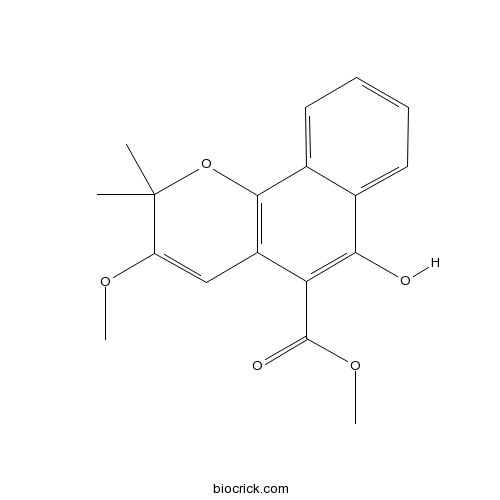3-MethoxymolluginCAS# 154706-44-2 |

Quality Control & MSDS
3D structure
Package In Stock
Number of papers citing our products

| Cas No. | 154706-44-2 | SDF | Download SDF |
| PubChem ID | 46187191 | Appearance | Powder |
| Formula | C18H18O5 | M.Wt | 314.33 |
| Type of Compound | Phenols | Storage | Desiccate at -20°C |
| Solubility | Soluble in Chloroform,Dichloromethane,Ethyl Acetate,DMSO,Acetone,etc. | ||
| Chemical Name | methyl 6-hydroxy-3-methoxy-2,2-dimethylbenzo[h]chromene-5-carboxylate | ||
| SMILES | CC1(C(=CC2=C(O1)C3=CC=CC=C3C(=C2C(=O)OC)O)OC)C | ||
| Standard InChIKey | OCQKAHAAVZGZPO-UHFFFAOYSA-N | ||
| Standard InChI | InChI=1S/C18H18O5/c1-18(2)13(21-3)9-12-14(17(20)22-4)15(19)10-7-5-6-8-11(10)16(12)23-18/h5-9,19H,1-4H3 | ||
| General tips | For obtaining a higher solubility , please warm the tube at 37 ℃ and shake it in the ultrasonic bath for a while.Stock solution can be stored below -20℃ for several months. We recommend that you prepare and use the solution on the same day. However, if the test schedule requires, the stock solutions can be prepared in advance, and the stock solution must be sealed and stored below -20℃. In general, the stock solution can be kept for several months. Before use, we recommend that you leave the vial at room temperature for at least an hour before opening it. |
||
| About Packaging | 1. The packaging of the product may be reversed during transportation, cause the high purity compounds to adhere to the neck or cap of the vial.Take the vail out of its packaging and shake gently until the compounds fall to the bottom of the vial. 2. For liquid products, please centrifuge at 500xg to gather the liquid to the bottom of the vial. 3. Try to avoid loss or contamination during the experiment. |
||
| Shipping Condition | Packaging according to customer requirements(5mg, 10mg, 20mg and more). Ship via FedEx, DHL, UPS, EMS or other couriers with RT, or blue ice upon request. | ||
| Description | 1. 3-Methoxymollugin is a cytotoxic compound. |

3-Methoxymollugin Dilution Calculator

3-Methoxymollugin Molarity Calculator
| 1 mg | 5 mg | 10 mg | 20 mg | 25 mg | |
| 1 mM | 3.1814 mL | 15.9068 mL | 31.8137 mL | 63.6274 mL | 79.5342 mL |
| 5 mM | 0.6363 mL | 3.1814 mL | 6.3627 mL | 12.7255 mL | 15.9068 mL |
| 10 mM | 0.3181 mL | 1.5907 mL | 3.1814 mL | 6.3627 mL | 7.9534 mL |
| 50 mM | 0.0636 mL | 0.3181 mL | 0.6363 mL | 1.2725 mL | 1.5907 mL |
| 100 mM | 0.0318 mL | 0.1591 mL | 0.3181 mL | 0.6363 mL | 0.7953 mL |
| * Note: If you are in the process of experiment, it's necessary to make the dilution ratios of the samples. The dilution data above is only for reference. Normally, it's can get a better solubility within lower of Concentrations. | |||||

Calcutta University

University of Minnesota

University of Maryland School of Medicine

University of Illinois at Chicago

The Ohio State University

University of Zurich

Harvard University

Colorado State University

Auburn University

Yale University

Worcester Polytechnic Institute

Washington State University

Stanford University

University of Leipzig

Universidade da Beira Interior

The Institute of Cancer Research

Heidelberg University

University of Amsterdam

University of Auckland

TsingHua University

The University of Michigan

Miami University

DRURY University

Jilin University

Fudan University

Wuhan University

Sun Yat-sen University

Universite de Paris

Deemed University

Auckland University

The University of Tokyo

Korea University
- Tezampanel
Catalog No.:BCC1993
CAS No.:154652-83-2
- Efavirenz
Catalog No.:BCC4135
CAS No.:154598-52-4
- Stauprimide
Catalog No.:BCC7768
CAS No.:154589-96-5
- SB 204990
Catalog No.:BCC6342
CAS No.:154566-12-8
- CHM 1
Catalog No.:BCC2387
CAS No.:154554-41-3
- Sinapaldehyde glucoside
Catalog No.:BCN1689
CAS No.:154461-65-1
- Methyl 5-O-feruloylquinate
Catalog No.:BCN3402
CAS No.:154461-64-0
- LY 303511
Catalog No.:BCC1715
CAS No.:154447-38-8
- LY 294002
Catalog No.:BCC3659
CAS No.:154447-36-6
- NU 7026
Catalog No.:BCC3933
CAS No.:154447-35-5
- Fmoc-Arg(Pbf)-OH
Catalog No.:BCC3040
CAS No.:154445-77-9
- Pramanicin
Catalog No.:BCN1853
CAS No.:154445-05-3
- 2-(2'-Hydroxytetracosanoylamino)-octadecane-1,3,4-triol
Catalog No.:BCN1555
CAS No.:154801-30-6
- Cimiside E
Catalog No.:BCN7951
CAS No.:154822-57-8
- 4-Acetoxycinnamic acid
Catalog No.:BCN5026
CAS No.:15486-19-8
- Eleutheroside C
Catalog No.:BCN1690
CAS No.:15486-24-5
- 3,5-Dihydroxy-4',7-dimethoxyflavone
Catalog No.:BCN1691
CAS No.:15486-33-6
- Kaempferol 3,7,4'-trimethylether
Catalog No.:BCN4087
CAS No.:15486-34-7
- LL 37
Catalog No.:BCC8027
CAS No.:154947-66-7
- BAY-u 9773
Catalog No.:BCC7576
CAS No.:154978-38-8
- Erysenegalensein E
Catalog No.:BCN3979
CAS No.:154992-17-3
- RU 58841
Catalog No.:BCC1911
CAS No.:154992-24-2
- Methscopolamine
Catalog No.:BCC4577
CAS No.:155-41-9
- Rhaponiticin
Catalog No.:BCN5392
CAS No.:155-58-8
New pyranonaphthoquinone and pyranonaphthohydroquinone from the roots of Pentas longiflora.[Pubmed:12350172]
J Nat Prod. 2002 Sep;65(9):1377-9.
Several quinone type compounds were isolated from the hexane, dichloromethane, and ethyl acetate extracts of the roots of Pentas longiflora. The hexane extract afforded two new compounds, [(3alpha,3'alpha,4beta,4'beta)-3,3']-dimethoxy-cis-[4,4'-bis(3,4,5,10-tetrahydro- 1H-naphtho[2,3-c]pyran)]-5,5',10,10'-tetraone (1) and cis-3,4-dihydroxy-3,4-dihydromollugin (2), together with six known compounds, namely, pentalongin, mollugin, trans-3,4-dihydroxy-3,4-dihydromollugin, methyl-2,3-epoxy-3-prenyl-1,4-naphthoquinone-2-carboxylate, tectoquinone, and 3-hydroxymollugin. From the dichloromethane extract were isolated the three known compounds 3-Methoxymollugin, methyl-3-prenyl-1,4-naphthoquinone-2-carboxylate, and scopoletin, while the ethyl acetate extract afforded the known 2-methoxy-3-methylanthraquinone.
Synthesis of the natural products 3-hydroxymollugin and 3-methoxymollugin.[Pubmed:20201485]
J Org Chem. 2010 Apr 2;75(7):2274-80.
3-Hydroxymollugin 2 and 3-Methoxymollugin 3 are cytotoxic compounds isolated as minor compounds from Pentas longiflora and Rubia cordifolia. Syntheses of 3-hydroxymollugin 2 and 3-Methoxymollugin 3 were developed starting from easily available 3-bromomollugin 6. Surprisingly, it was found that the reaction of 3-bromomollugin 6 with sodium methoxide in methanol resulted in the formation of 3-Methoxymollugin 3 and the ring-contracted methyl isopropenylfuromollugin 7. A mechanism for this ring contraction is proposed on the basis of a pericyclic retro oxa-6pi ring-opening reaction. A second synthesis of 3-hydroxymollugin 2 was based on epoxidation of methyl 3-(3-methylbut-2-enyl)-1,4-naphthoquinone-2-carboxylate 17 and subsequent reduction of the quinone moiety, ring transformation, and DDQ oxidation. The latter oxidation process results in 3-hydroxymollugin 2 along with the rearranged furomollugin 4, which is a ring-contracted analogue of the natural product mollugin 1.


